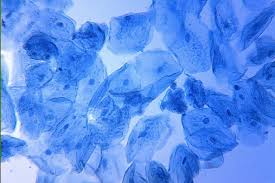Cheek Cells Under a Microscope
Requirements, Preparation and Staining
Cheek cells are eukaryotic cells (cells that contain a nucleus and other organelles within enclosed in a membrane) that are easily shed from the mouth lining. It's therefore easy to obtain them for observation.
Some of the main parts of a cell include:
1. Cell membrane (outer boundary of the cell)
2. Cytoplasm (the fluid within the cell)
3. Nucleus (at the center of the cell and controls cell functions)
4. Organelles (e.g. mitochondria-Organelles are cell structures with specific functions)
Using biological stains such as methylene blue, it's possible to clearly observe and differentiate the different parts of a cell. This is because the stain will color some parts of the cell and not others, allowing them to be clearly observed.
Requirements
- Sterile cotton swab
- Clean, sterile microscope slides
- Microscope cover slips
- Methylene Blue solution (0.5% to 1%)
- Dropper
- Blotting paper/Tissue paper
- Microscope
How to Prepare a Wet Mount of Cheek Cells
Before starting, it's always important to ensure that the working surface is clean and that you are wearing a pair of clean gloves to avoid contamination.
Cheek cells can be
easily obtained by gently scraping the inside of the mouth using a clean,
sterile cotton swab.
Once the cells have been obtained, the following procedure is used for cheek cell wet mount preparation:
- place a drop of physiological saline on a clean microscopic slide (central part of the slide)
- smear the cotton swab on to the center (part containing the saline drop) of the clean slide for about 4 seconds to get the cells on to the center of the slide
- add a drop of methylene blue solution on to the smear and gently place a cover slip on top (to cover the stain and the cells)
- any excess solution can be removed by touching one side of the slide with a paper towel or blotting paper.
- place the slide on the microscope for observation using 4 x or 10 x objective to find the cells
- once the cells have been found, they can then be viewed at higher magnificatio
* Note - Used cotton swabs and cotton towel should be safely discarded in the trash and not left lying on the working table.
Why do we have to Stain the Cells?
The cell has different parts, and those that can absorb stains or dyes are referred to as chromatic. Having absorbed the stain, these parts of the cell become more visible under the microscope and can therefore be easily distinguished from other parts of the same cell.
Without stains, cells would appear to be almost transparent,
making it difficult to differentiate its parts.
Methylene blue has a string affinity for both DNA and RNA. When it comes in contact with the two, a darker stain is produced and can be viewed under the microscope.
The nucleus at the central part of the cheek cell contains DNA. When a drop of methylene blue is introduced, the nucleus is stained, which makes it stand out and be clearly seen under the microscope.
Although the entire cell appears light blue in color, the nucleus at the central part of the cell is much darker, which allows it to be identified.
Observation
On mounting the wet slide, the following will be observed:
- Large irregularly shaped cells with distinct cell membranes.
- A distinct nucleus at the central part of each individual cell (dark blue in color).
- A lightly stained cytoplasm in each cell.
Conclusion
This is an easy and fun experiment that will show kids the basic structure of a cell and its major parts. For easy identification of the parts, the parent or teacher can first show the kids some samples of the cells in advance.This will help them identify different parts with ease.
Once this has been achieved, kids can move on to the next stage of learning the functions of these different parts.
** Find prepared microscope slides and equipment to correctly perform microscope experiments.
See also: Epithelial Cells
See differences between cytosol and cytoplasm here.
Other similar fun experiments - Onion Cells , Sugar Crystals, Cork Cells, Taking a look at leaves and Hair Under the Microscope
Return to Beginner Microscope Experiments
Return from Cheek Cells to MicroscopeMaster Home
Find out how to advertise on MicroscopeMaster!





